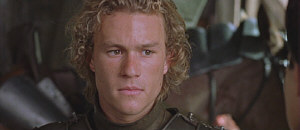 For whatever reason, films set in medieval times just don’t seem to do a lot of business. From Excalibur to Dragonslayer and with many stops in between, movies have tried a mix of approaches toward the material, but the box office receipts remain modest at best. Has there ever been a genuine hit that worked with that era? Probably, but I can’t think of one off of the top of my head, and some modest research turned up no exceptions to my rule.
For whatever reason, films set in medieval times just don’t seem to do a lot of business. From Excalibur to Dragonslayer and with many stops in between, movies have tried a mix of approaches toward the material, but the box office receipts remain modest at best. Has there ever been a genuine hit that worked with that era? Probably, but I can’t think of one off of the top of my head, and some modest research turned up no exceptions to my rule.
In 2001, we got yet another attempt to plumb the period, and this one looked like it had a shot. A Knight’s Tale starred rising heartthrob Heath Ledger and took a gleefully anachronistic tone that looked like it might connect modern audiences to ye olden days. However, the results weren’t all that positive. It grabbed a $56 million gross, which was pretty disappointing for a big summer flick.
A Knight’s Tale holds the distinction of being one of very few “popcorn movies” that my father liked. Unfortunately, his endorsement usually means the kiss of death to me; Dad and I don’t often agree on films. Although I didn’t dislike Tale, I can’t say I concurred with my father’s opinion, as I thought it was a generally entertaining but unspectacular piece of work.
A Knight’s Tale follows the story of William Thatcher (Ledger), squire to a knight named Sir Ector. At the film’s start, Ector buys the farm after a jousting match. Since he almost achieved victory - which meant a nice payday for William and his cohorts Wat (Alan Tudyk) and Roland (Mark Addy) - William decides to pretend to be Ector to finish the contest. He does so, they get their loot, and that’s that, right?
 Wrong. William takes this success as a sign and decides to fake nobility so he can enter these sorts of tournaments on his own. Neither Wat nor Roland seem enthused about this, but they agree to give it a shot, and a chance meeting with a down-on-his-luck - and naked - Geoffrey Chaucer (Paul Bettany) offers possible assistance; he can forge the necessary documentation of William’s heritage. Rechristened Sir Auric von Lichtenstein of Gelderland, William quickly hits the field and becomes a success.
Wrong. William takes this success as a sign and decides to fake nobility so he can enter these sorts of tournaments on his own. Neither Wat nor Roland seem enthused about this, but they agree to give it a shot, and a chance meeting with a down-on-his-luck - and naked - Geoffrey Chaucer (Paul Bettany) offers possible assistance; he can forge the necessary documentation of William’s heritage. Rechristened Sir Auric von Lichtenstein of Gelderland, William quickly hits the field and becomes a success.
Along the way, matters become complicated. As one expects from a movie, William develops both a love interest and an archenemy. In the former capacity we find Jocelyn (Shannyn Sossamon), a lovely but elusive young woman, and in the latter category stands Count Adhemar (Rufus Sewell), a nasty dude who accurately sees William/Auric as a challenge to his jousting hegemony.
With this cast of characters in place - plus Kate (Laura Fraser), the most beautiful blacksmith you’re ever likely to see - Tale takes an inevitable path. William/Auric becomes the top dog but doesn’t get his ultimate goal to fight Adhemar because the latter is off at war. We also see a subtext in which William needs to discover himself and come to terms with his roots; his father (Christopher Cazenove) sent him off to be Ector’s assistant at a very young age, and William seems to fear his eventual homecoming. All of this leads toward the predictable climactic battle between William and Adhemar.
I won’t divulge all the details about what occurs, but let’s just say that A Knight’s Tale holds few surprises. However, I don’t really regard that as a flaw. The film’s essentially just another underdog against the odds story, sort of like Rocky with staffs and horses. The vast majority of movies feature pretty predictable plots, so I think it’s much more important to see what the director does with the material; I worry less about the originality of the story itself. Actually, sometimes attempts to alter the usual course of things seem worse than the standard sequences; such changes can come across as forced and self-conscious.
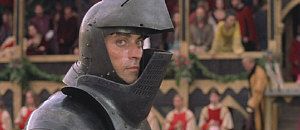 Anyway, you’ll find few surprises during Tale, though director Brian Helgeland leavens the activity with an anachronistic tone. He makes no attempt to create an authentic rendition of the era, and this attitude comes through clearly during the first jousting scene; fans sing Queen’s “We Will Rock You” while air horns bleat in the background. Helgeland follows this with quite a few other attempts to meld eras.
Anyway, you’ll find few surprises during Tale, though director Brian Helgeland leavens the activity with an anachronistic tone. He makes no attempt to create an authentic rendition of the era, and this attitude comes through clearly during the first jousting scene; fans sing Queen’s “We Will Rock You” while air horns bleat in the background. Helgeland follows this with quite a few other attempts to meld eras.
While this attitude possessed a potential spark, I thought it ultimately seemed like little more than an attempt to be different for the sake of being different. At its heart, Tale was a very traditional story, and it progresses in an unexceptional manner. It felt as though Helgeland introduced the anachronistic elements simply to make the movie stand out in some way. That’s fine, I suppose, but I thought those bits added nothing to the film, and they appeared gratuitous. I didn’t think the rock music and other nods to modern society really harmed the flick, but I felt they didn’t contribute to it either. Helgeland lacks the skill and style to pull them off fully, so they seemed tacked on to a degree.
Really, very little about Tale made it stand out, though the jousting scenes were surprisingly vivid and exciting. Jousting always seemed like a dull sport, as all we see are a couple of guys who try to knock each other off their horses. Hey, at least the videogame Joust put the participants on ostriches to enliven the proceedings!
However, Helgeland was able to bring a great deal of flair and impact to the events. He brought home the intense violence of the games and made them appear much more brutal and rough than usual. As such, these scenes provided some of the movie’s best elements, and they allowed the film’s ending to become truly climactic.
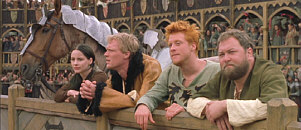 Otherwise, Tale seemed like a pretty ordinary flick. Ledger will have to wait for another day to attain major stardom, and I saw little in his performance to indicate much beyond his pretty face. Actually, I think he’s a decent enough actor, and he’s done well with supporting roles in movies like The Patriot. I just don’t feel like he can quite carry a movie on his own yet. He seemed vaguely likable and engaging as William, but he failed to provide a real star presence or magnetism.
Otherwise, Tale seemed like a pretty ordinary flick. Ledger will have to wait for another day to attain major stardom, and I saw little in his performance to indicate much beyond his pretty face. Actually, I think he’s a decent enough actor, and he’s done well with supporting roles in movies like The Patriot. I just don’t feel like he can quite carry a movie on his own yet. He seemed vaguely likable and engaging as William, but he failed to provide a real star presence or magnetism.
Most of the supporting cast offered able work, though none really stood out from the crowd. Sidekicks Wat, Roland and Chaucer had their own defining characteristics, but the movie never fleshed them out much, so they all felt ill defined as a whole. As for Jocelyn, Lisa Bonet reincarnation Shannyn Sossamon looked pretty good in the role, but she showed little personality or spark in the part, and I felt the combination of Sossamon and Ledger failed to demonstrate much chemistry. It didn’t help that some of the other actresses were just as lovely as Sossamon; it never made sense that William was so stuck on Jocelyn when blacksmith Kate and Jocelyn’s handmaiden Christiana (Bérénice Bejo) were just as gorgeous.
In the end, I thought that A Knight’s Tale offered a generally enjoyable experience, but it never threatened to become anything more than that. It gently recast the traditional medieval film with modern elements, although it stayed with a very traditional storyline. Most parts of the movie seemed well executed, but other than the thrilling jousting scenes, none of them excelled. Tale was a slightly above-average popcorn flick, but it didn’t make a substantial impact upon me.
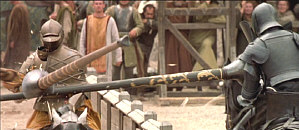 Postscript one: those who enjoyed the film will want to stick it out through the completion of the end credits. A minor finishing sequence pops up at that time. Don’t expect cinematic treasure, but it’s a neat reward for anyone who goes that far.
Postscript one: those who enjoyed the film will want to stick it out through the completion of the end credits. A minor finishing sequence pops up at that time. Don’t expect cinematic treasure, but it’s a neat reward for anyone who goes that far.
Postscript two: no one ever mentions this during the supplements, but I’d be curious to know if any parts of Tale were inspired by the 1963 Disney flick The Sword In the Stone. In addition to the theme of the commoner who achieves nobility, that film featured a character named Sir Ector and another called Wart. “Wart” sounds a lot like “Wat”. Coincidence or intentional link? Apparently Helgeland’s not telling.
The DVD:
A Knight’s Tale appears in an aspect ratio of approximately 2.35:1 on this single-sided, double-layered DVD; the image has been enhanced for 16X9 televisions. Though not totally flawless, the picture nonetheless provided a consistently excellent presentation that featured very few concerns.
Sharpness always appeared very crisp and concise. At no did time I discern any examples of softness or fuzziness, as the movie remained detailed and accurate throughout the film. No moiré effects or jagged edges appeared, but I did notice some minor edge enhancement at times. The print used seemed to be totally clean; I detected no examples of any form of source flaws.
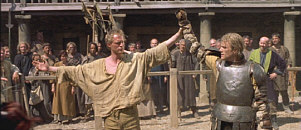 Colors usually looked nicely natural and warm, and the medieval world seemed to be accurately depicted in that regard. Really, almost all of the hues were quite lovely and vibrant, but one problem occurred: flesh tones. At times I thought faces looked a bit too ruddy, and they could vary throughout the film. Some of this made sense, as one expects pinkish faces from the people depicted, but the coloring looked somewhat erratic, and the inconsistency caused my concern.
Colors usually looked nicely natural and warm, and the medieval world seemed to be accurately depicted in that regard. Really, almost all of the hues were quite lovely and vibrant, but one problem occurred: flesh tones. At times I thought faces looked a bit too ruddy, and they could vary throughout the film. Some of this made sense, as one expects pinkish faces from the people depicted, but the coloring looked somewhat erratic, and the inconsistency caused my concern.
Black levels appeared to be very deep and rich, and shadow detail looked appropriately heavy but not excessively thick. The low light sequences demonstrated fine definition and they came across as nicely opaque but still visible. The majority of A Knight’s Tale offered a genuinely outstanding visual experience, but some concerns related to light edge enhancement and skin tones led me to lower my grade to a still-terrific “A-“.
Also excellent was the Dolby Digital 5.1 soundtrack of A Knight’s Tale. The soundfield provided a very broad and engaging affair that seemed wonderfully engulfing. From the front spectrum, audio appeared nicely localized. The music demonstrated solid stereo separation, and a variety of effects popped up from the appropriate places in the side speakers. These elements blended together quite naturally and smoothly, and they panned across channels cleanly.
Surround usage was a major factor in this mix, and the rears took the soundtrack to a higher level. Both the score and the many rock songs heard spread nicely to the back speakers, but they remained largely within the realm of general reinforcement. Where the mix worked especially well regarded effects, which became a major force in the surrounds. A great deal of accurate and lively material appeared in the rear channels, especially during the jousting sequences. Knights rode by convincingly, and their battles displayed excellent atmosphere. Overall, the soundfield was quite well defined and involving.
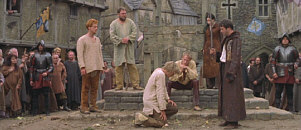 Audio quality also seemed to be terrific. Despite the fact that much of the speech needed to be looped, dialogue sounded natural and warm throughout the film; I detected no problems related to intelligibility or edginess, and the speech appeared nicely crisp and distinct. Music usually sounded bright and lively, though some variations occurred due to the source material. For example, AC/DC’s “You Shook Me All Night Long” was direct and forceful, but David Bowie’s “Golden Years” seemed somewhat muddy and vague. I’ve heard the latter song a few billion times, so I know it can - and should - sound better than that. Nonetheless, most music appeared quite vivid and clear, so my complaints remained minor.
Audio quality also seemed to be terrific. Despite the fact that much of the speech needed to be looped, dialogue sounded natural and warm throughout the film; I detected no problems related to intelligibility or edginess, and the speech appeared nicely crisp and distinct. Music usually sounded bright and lively, though some variations occurred due to the source material. For example, AC/DC’s “You Shook Me All Night Long” was direct and forceful, but David Bowie’s “Golden Years” seemed somewhat muddy and vague. I’ve heard the latter song a few billion times, so I know it can - and should - sound better than that. Nonetheless, most music appeared quite vivid and clear, so my complaints remained minor.
Effects remained the stars of the show, as they displayed fine fidelity and dynamics. Again, the battle sequences were the strongest parts of the film, especially during jousting scenes. At those times the mix packed a serious wallop as the participants clashed to fine effect. Bass response was nicely deep and rich, and it remained tight at all times. I thought some of the music could have showed stronger low end, but these concerns were fairly inconsequential. Ultimately, the soundtrack of A Knight’s Tale worked tremendously well as a whole.
On this special edition DVD of A Knight’s Tale, we find a slew of extras. First we discover an audio commentary from writer/director Brian Helgeland and actor Paul Bettany. Both men were recorded together for this running, screen-specific track. Though it occasionally seemed a little short on hard facts, the piece offered a lively and engaging tone that helped make it a success.
 Bettany and Helgeland maintained a very positive chemistry and they really played off each other nicely. This meant that although the piece didn’t feature a wealth of information about the making of a major movie, we did get a tremendous number of fun anecdotes from the set and discussions of silly aspects of the flick. They gave us many trivial but entertaining remarks that made this commentary a consistent delight. They’re more than willing to point out mistakes and inconsistencies found in the movie. Did I learn much about the filmmaking process? Not really, but I didn’t care, as the track added enough witty and compelling material to be a genuine winner. This was one of the most funny, engaging and entertaining pieces I’ve heard in a while.
Bettany and Helgeland maintained a very positive chemistry and they really played off each other nicely. This meant that although the piece didn’t feature a wealth of information about the making of a major movie, we did get a tremendous number of fun anecdotes from the set and discussions of silly aspects of the flick. They gave us many trivial but entertaining remarks that made this commentary a consistent delight. They’re more than willing to point out mistakes and inconsistencies found in the movie. Did I learn much about the filmmaking process? Not really, but I didn’t care, as the track added enough witty and compelling material to be a genuine winner. This was one of the most funny, engaging and entertaining pieces I’ve heard in a while.
Next we locate a number of video features. A whopping 11 “behind the scenes” featurettes appear. This means that we get 11 short snippets that examine various aspects of the film. Each of the clips lasts between 95 seconds and five minutes, 50 seconds for a total of 33 minutes and 10 seconds of footage. These might have been better presented as one running documentary - the lack of a “play all” option seemed very irritating - but I still found the featurettes to be generally solid.
Each took on a different topic. These included the film’s tone, costume design, sets and cultural differences on location in Europe, shooting the tournaments, the history of tournaments and jousting, facts about heralds, Chaucer and courtship in the era, and basic discussions of Ledger and Helgeland. These consisted of small interview snippets as well as movie bits and shots from the set, and they added a lot of good information about the movie. Again, they might have worked better as one integrated program, but I still thought these were enjoyable pieces; they were definitely more interesting than the average featurettes.
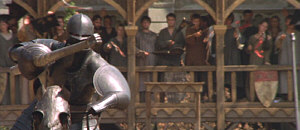 More information about the movie popped up in the HBO Making-of Special. This 15-minute program followed the usual process, as it provided interview snippets, clips from the movie, and material from the set. Some of the stuff was good, especially in regard to the behind the scene footage, but most of it became redundant in conjunction with the featurettes. Really, those pieces made this special fairly superfluous; any segments that didn’t appear in the featurettes weren’t very useful, as they tended toward the promotional side of the coin.
More information about the movie popped up in the HBO Making-of Special. This 15-minute program followed the usual process, as it provided interview snippets, clips from the movie, and material from the set. Some of the stuff was good, especially in regard to the behind the scene footage, but most of it became redundant in conjunction with the featurettes. Really, those pieces made this special fairly superfluous; any segments that didn’t appear in the featurettes weren’t very useful, as they tended toward the promotional side of the coin.
Definitely more interesting was the collection of Deleted Scenes. We found six of these. Each lasted between 50 seconds and eight minutes, 50 seconds for a total of 21 and a half minutes of footage. Though I felt none were truly terrific, most seemed like interesting additions to the package. I can’t claim any should have remained in the movie, but I enjoyed being able to give them a look, and they were fun to see.
I definitely understood why the clips were excised when I checked them out along with “Filmmakers’ Introductions”. This presentation was unusual. Director/writer Helgeland and editor Kevin Stitt discussed the snippets before we saw them, but they also spoke on top of the material. The clips also included some shots from the set. Helgeland and Stitt added good information about the scenes, and they made it very clear why they failed to make the cut. These were some of the best filmmaker comments about deleted scenes that I’ve heard.
A mix of smaller extras rounded out the disc. A fun music video for “We Are The Champions” by Robbie Williams + Queen appeared. Though the clip used the standard format as it combined film snippets and a lip-synched performance, it placed the action back in the 14th century and seemed to be fairly witty and compelling. Filmographies appeared for writer/director Helgeland as well as actors Heath Ledger, Mark Addy, Rufus Sewell, Paul Bettany, and Alan Tudyk, and we got trailers for A Knight’s Tale and Final Fantasy: The Spirits Within. Some short Production Notes showed up inside the DVD’s booklet.
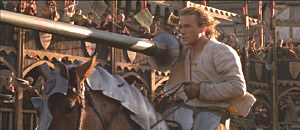 For those with DVD-ROM drives, some additional pieces can be accessed. In addition to a weblink to the official movie site, we find a special “3-D visualizer screensaver”. I tried to install the latter, but the stupid thing crashed my computer! I can’t say that’ll happen to everyone, but I’m not giving it another shot.
For those with DVD-ROM drives, some additional pieces can be accessed. In addition to a weblink to the official movie site, we find a special “3-D visualizer screensaver”. I tried to install the latter, but the stupid thing crashed my computer! I can’t say that’ll happen to everyone, but I’m not giving it another shot.
While A Knight’s Tale didn’t create a financially successful medieval flick, it did offer a reasonably entertaining program that had some fun moments. It was a decent but unspectacular film that followed a predictable path but it provided a fairly fun exercise along the way. The DVD provided very strong picture and sound plus a very nice roster of extras, highlighted by a terrific audio commentary and some interesting deleted scenes. Although A Knight’s Tale wasn’t a great film, this was a terrific DVD, and the combination of fairly good movie and excellent disc made this a platter to pursue.